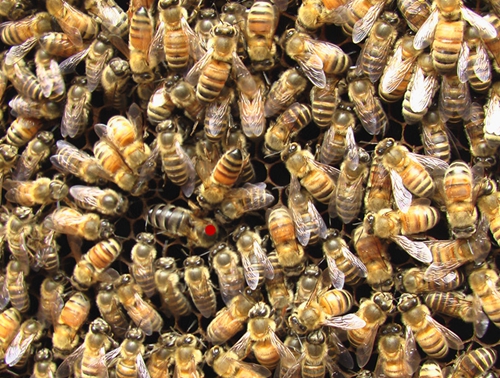In highly social bees, queen mandibular pheromone (QMP) plays a central role in colony life and has multiple factors. All of the major compounds ((E)-9-oxodec-2-enoic acid (9-ODA), (E)-9-hydroxydec-2-enoic acid (9-HDA), (E)-10-hydroxy-dec-2-enoic acid (10-HDA), 10-hydroxy-decanoic acid (10-HDAA), and methyl p–hydroxybenzoate (HOB)) found in western honey bees (Apis mellifera) QMP are also found in eastern honey bees (Apis cerana) QMP. However, the species differences could arise from multiple factors.
It is important to examine the sensory input (antennal olfactory sensitivity) and an immediate behavioral output, physical attraction and movement towards a component.
Prof. TAN Ken and his team of Xishuangbanna Tropical Botanical Garden (XTBG) conducted a study to compare the antennal responses and worker cluster (retinue) formation behaviors of eastern honey bee workers and western honey bee workers to identical presentations of major-component QMP blends and individual QMP components.
The researchers used electroantennograms (EAG) to measure antennal sensitivities. They tested responses to major QMP blends that contained the most abundant components found in the QMP of each species and individual compounds.
They found that western honey bees had significantly stronger antennal responses to the major QMP blends and to some individual compounds than eastern honey bees.
4-hydroxy-3-methoxyphenylethanol (HVA) was not found in eastern honey bee QMP, but eastern honey bee workers showed antennal responses to this compound.
The researchers then measured the attraction of individual QMP compounds with a retinue bioassay. Three compounds (9-HDA, HOB, and 10-HDA) attracted significantly more western honey bees than eastern honey bee workers. Eastern honey bees were never significantly more attracted than western honey bees.
The study entitled “Resisting majesty:Apis cerana, has lower antennal sensitivity and decreased attraction to queen mandibular pheromone than Apis mellifera” has been published in Scientific Reports.
Contact
TAN Ken, Ph.D Principal Investigator
Key Laboratory of Tropical Forest Ecology, Xishuangbanna Tropical Botanical Garden, Chinese Academy of Sciences, Mengla, Yunnan 666303, China
Tel: 86-871-65227717
Fax: 86-871-65227358
E-mail: kentan@xtbg.ac.cn

Worker cluster (retinue) of honey bees (Image by DONG Shihao)

